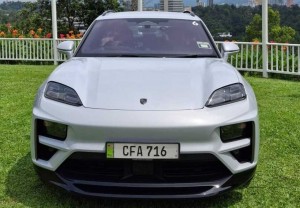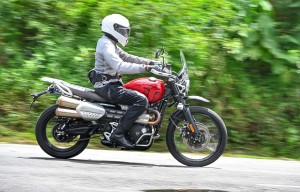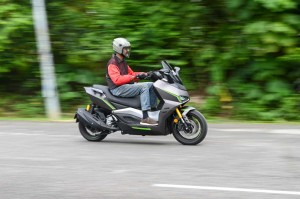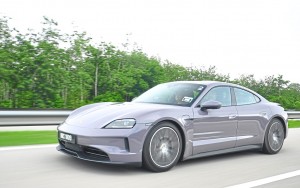MARRAKESH: Ferrari NV unveiled the Roma Spider on Thursday, the first of four supercars the company plans to release this year.
The Ferrari Roma Spider features a 612-horsepower 3.9-litre V8 turbo engine and can reach a top speed of about 320kph, the Italian carmaker said in a statement.
It evokes carefree 1950s styling with a soft top that deploys in just 13.5 seconds even while driving at up to 60kph.
Ferrari has hiked prices on some of its cars and is benefiting from wealthy buyers being less acutely affected by soaring inflation and rising interest rates.
The company is preparing to shift to electric vehicles and turn its historic factory in northern Italy into a hub for battery-powered cars.
Roma Spider in detail
This spider carries over the proportions, volumes and specifications of the Ferrari Roma’s hugely successful V8 2+ concept, but what makes it so striking is the adoption of a soft top, a solution making a welcome return to the Prancing Horse range on a front-engined car 54 years after the 1969 365 GTS4.
The soft top deploys in 13.5 seconds and can be opened or closed at up to 60 kph. The fact that it is so compact also yields a larger boot and boosts the car’s versatility.
A new, patented wind deflector integrated into the backrest of the rear bench can be deployed by a button on the central tunnel to ensure in-car occupant comfort without taking up any space in the car.

The Roma Spider retains the Roma’s excellent dynamic characteristics: it boasts a best-in-class weight/power ratio thanks not only to its soft top, but also to its all-aluminium chassis and 612hp V8 from the engine family that was heralded as the International Engine of the Year on four consecutive occasions.
The engine is coupled with an 8-speed DCT known for its fast shift times.
Designed by the Ferrari Styling Centre headed by Flavio Manzoni, the Roma Spider aims to move the “La Nuova Dolce Vita” concept beyond city limits for elegant, carefree driving ‘en plein air’.
This 2+ spider boasts a sophisticated fabric soft top, which is designed not just to maintain, but to enhance the sleek proportions of the coupé on which it is based without modifying that car’s flowing silhouette.

Redesigning the coupé’s tapering, fastback roofline meant modifying the rear screen to incorporate it into the soft top so that it can fold below the tonneau cover when open.
The long front bonnet underscores the spare silhouette of the flanks, lending a sense of sleekness to the entire body and a dynamic look. The sober, spare front of the car looks as if it were sculpted from single block of metal, creating an overhanging, sharknose effect.
The bonnet and sinuous wings flow into one another. The designers sought to preserve the minimalist elegance of the car’s forms by removing any vents or superfluous decorative features. In fact, the launch configuration does not even include the Scuderia Ferrari side shields, reflecting the approach taken with the road cars of the 1950s.
Engine cooling is guaranteed by the perforated surfaces, only where strictly necessary, creating a new interpretation of the grille concept: this distinctive solution is finished in the same colour as the bodywork, rendering it seamless with the styling. The edges of the front grille flow into two linear, full-LED headlights which lend the front of the car a distinctive character all of its own.
They are traversed by a horizontal DRL strip that hints at the structure beneath the car’s skin, an element that brings a sense of tension to the entire circumference of the car.

The fastback cabin volume is compact and set back, ending in a subtle nolder beneath which the designers have created a modern take on the signature Ferrari tail. The Roma Spider’s long rear overhang, which is a characteristic of the Ferraris of the 1950s and 60s, has been re-proportioned here, resulting in a low, compact volume which hugs the rear axle.
Technological advances made it possible to reduce the dimensions of the tail light assembly, resulting in a minimalist and iconic design. The rear is completed by a compact aerodynamic diffuser that incorporates the fence and exhaust tailpipes.
For the Roma Spider’s cabin, the Ferrari Styling Centre designers took the same approach to volumes and forms introduced on the Roma.
Two separate spaces, one each for driver and passenger, were created in an evolution of the dual cockpit concept, which has its roots deep in the marque’s history with cars from the 1970s.
The innovative look of this dual cockpit was achieved by extending the philosophy applied to the dash to the entire cabin. Hence, the vision of two modules that wrap around driver and passenger and that extend and integrate with the two rear seats.

The Roma Spider boasts Variable Boost Management, a control software developed by Ferrari that adjusts torque delivery to suit the gear selected, delivering increasingly powerful pick-up as revs rise, whilst optimising fuel consumption.
As the car goes up through the gears, the amount of torque delivered by the engine increases, continuing all the way up to 760 Nm in 7th and 8th gear. This allowed the use of longer gear ratios in the higher gears, which helps keep fuel consumption and emissions down, while adopting a steeper torque curve through the rev range in the lower gears for a feeling of smooth, consistent pick-up.
The gearbox is based on a dual-clutch oil bath architecture and is derived from the 8-speed gearbox first introduced on the SF90 Stradale.
The main modifications made with respect to the latter are longer gear ratios and the introduction of a reverse gear. The new layout and component integration thus optimised the gearbox’s size and its installation in the car.
Like other models, the Roma Spider gets an extended seven-year maintenance programme, which covers all regular maintenance for the first seven years of the car’s life. - Additional details from Ferrari















